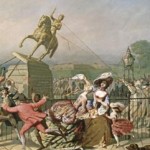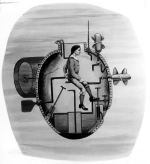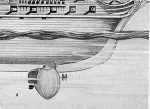Those led by dreams shall be misled, O King.
-William Sharp, “The Immortal Hour”
Acentury ago, the railroad was the cutting edge of practical technology, moving freight and people as the Internet now moves information and thought. One of the last and most spectacular railroad promoters was Arthur Stilwell. Some called him a visionary. Only toward the end would he reveal how visionary he was.
Stilwell was born in Rochester on October 21, 1859. Hamblin Stilwell, his grandfather, once brought Arthur to dinner with Commodore Cornelius Vanderbilt. When the old rogue asked the six-year-old what he wanted to do when he grew up, the boy replied, “I’m going West to build a railroad.” At fourteen or fifteen, Arthur ran away from home. He worked as a hotel clerk and a printer while selling advertising, insurance and even his own patent medicine: Stilwell’s Specific. At nineteen, he married Jennie Wood, his childhood sweetheart. They were inseparable for the rest of their lives.
Stilwell was a born salesman: he believed in himself and his products. His charm, energy, and enthusiasm made him radiate optimism. Tall and powerfully built, his blond good looks were enhanced by impeccable grooming and tailoring. Even as an adolescent, he wore bespoke suits: he ran away from home in part because his father wanted him to wear clothes off the rack.
He was already a Travelers Insurance vice president, drawing a phenomenal $8,000 salary, when he devised a real estate promotion. In 1886, he moved to Kansas City, established the Real Estate Trust Company with his life savings of $25,000, and successfully implemented his plan. Stilwell understood that railroad service skyrocketed real estate values. His first railroad promotion literally walked into the office: one of his associates came by on a Tuesday complaining that his railroad franchise–a permit to build a railroad–would expire Friday night for lack of construction. Stilwell glanced at the franchise, boarded the next train for Philadelphia, and formulated his plan on the train. On Friday morning, he persuaded Drexel, Drexel and Company, investment bankers impressed by Stilwell’s successful real estate operations and extraordinary charisma, to invest $300,000 in the Kansas City Suburban Belt Railroad. He telegraphed his partner at noon. Construction began within minutes.
Stilwell’s railroad promotions all involved watered securities. This meant the par value was greater than their actual worth. For example, he sold his investors six percent Suburban Belt bonds nominally worth $1,000 for $660, tossing in twenty shares of $100 par value common stock as a bonus. The trust company’s commission was the odd $16. The railroad thus received $600 cash for securities apparently worth $3,000. Of course, they were only so much fancy wallpaper until the railroad succeeded.
Stilwell, not yet forty, was rich. What his friends did not know was that the financier was literally a visionary: he believed in spirits and omens, heard voices, and saw visions. Their message, however, was how to combine real estate development with railroad construction and make money.
Stilwell had a hunch. He glanced at a wall map. Kansas City, though 1400 miles from the East Coast, is only 800 miles from the Gulf of Mexico. Cheap north-south rail transportation would bring wheat, corn, and lumber at competitive prices to Southern seaports. He organized the Kansas City, Pittsburg & Gulf Railway–the Pee-Gee for short–raised his first $3 million, and began driving south, “straight as the crow flies.” As his tracklayers moved toward the Gulf, Stilwell sold millions of dollars worth of securities in the Pee-Gee and its numerous subsidiaries and affiliates. In 1898, he would be president of fifty-two corporations.
Stilwell’s gift for public relations was amazing. For example, he began promoting real estate development at Mena, Arizona, the halfway point on the line, while the Pee-Gee was forty miles away. He announced that the Pee-Gee would be in Mena in forty days. He claimed no one in human history had ever laid an average of a mile of track a day. This was an outrageous lie. The Union Pacific had regularly laid five to ten miles of track daily some thirty years before. However, the reporters didn’t know that, didn’t check their facts, and no one bothered telling them, either.
His track gangs began laying a mile a day, every day, to a barrage of Stilwell media releases in the Eastern and European press. His clipping service kept his investors informed and the investors kept up the flow of funds. On August 19, 1896, forty days to the day after his boast, Arthur Stilwell rode the first steam locomotive into Mena.
The Pee-Gee’s last spike was driven on September 11, 1897. Its Gulf terminal was a new city, modestly named Port Arthur. Although his railroad was fundamentally sound, it was overextended: In the fall of 1900, a Wall Street ring headed by John W. “Bet-a-Million” Gates forced the Pee-Gee into receivership and Stilwell out of a job through a court order granted by a federal judge in a hearing held at the judge’s home at 2 a.m. over an unpaid $40 printing bill.
On February 10, 1900, Stilwell announced he would build a railroad from Kansas City to Topolobampo, Mexico, a Pacific seaport 500 miles closer than San Francisco. The Kansas City, Mexico & Orient Railway would unlock the riches of Mexico’s northwest while carrying through traffic from the East on a faster route to the Orient.
In fact, the Orient crosses a land of unrelenting loneliness, drought, blizzards, and locusts from the Staked Plains across miles of alkali desert to Chihuahua City. After that was the hard part: crossing the Sierra Madre to the Sea of Cortez. His engineers found this part of the line alone would require thirty-nine bridges, eighty-seven tunnels and three complete loops over itself to descend 300 feet in 122 miles through five climatic zones.
Nonetheless, the Mexican government granted the Orient a subsidy of 5000 silver pesos per kilometer, a ninety-nine-year title to its right of way and free importation of construction materials for five years. Stilwell placed numerous stories about the Orient in leading magazines and newspapers. He spoke at luncheons and dinners along the route and in Europe, where he sold millions of dollars’ worth of stocks, bonds and notes, based on his record with the Pee-Gee and other promotions.
Then came the revolution. One of Stilwell’s contractors was part of it. Stilwell had met the man face to face in 1907 and disliked him immediately because he smelled of hair oil. He had been born Doroteo Arango. At sixteen, he killed the man who had raped his sister, then made his way as a bank robber and thief. He was probably the only cattle rustler with the bravado to list himself in a city directory as a “wholesale meat dealer.” Mexicans still honor his 1916 raid on Columbus, New Mexico, as their country’s only victory in the 20th century against the North Americans. He was Pancho Villa.
In late 1910, Francisco Madero, a liberal revolutionist, took up arms against longtime President Porfirio Diaz, who had fixed one election too many. In April 1911, Villa joined Madero. Diaz left Mexico before the end of May. In a Kansas City Star interview, Stilwell complained that the revolutionists were blowing up bridges and tearing up track. Villa also robbed the Orient’s payrolls, killed its employees, and wrecked its trains.
Investors stopped buying Mexican securities. The Orient ran out of money only two-thirds complete. The peasants began calling the railroad “El Kansado” (from cansado, “the tired one”). On March 7, 1912, the Orient went into receivership and Stilwell was again out of a job. One accountant observed that $28 million had been raised and spent on a railroad worth no more than $8 million as scrap. Virtually every dollar raised by Stilwell for the Orient had gone into its construction. He had simply underestimated his expenses and operating profit. He later argued that even if the stockholders lost $20 million, the West and Mexico saw $250 million in increased property values. This is not what the investors wanted to hear. The Orient alone represents one-tenth of all foreign investment lost during the Mexican Revolution. The Mexican government completed the line across the Sierra Madre only in 1961, at a cost of $88 million. Topolobampo remains a fishing town.
Stilwell and his wife moved to France. Now his energy flowed into writing. He wrote Cannibals of Finance: Fifteen Years’ Contest with the Money Trust (1912). Stilwell never admitted responsibility for his failures. He even justified the Orient: a sound idea, honestly financed, with great potential. It was not his fault that crops failed, the Mexican Revolution broke out, and the money trust’s machinations cut off the railroad’s credit. (One hears the same thing from today’s dotcom promoters, who blame their investors for refusing to pour yet more money into unprofitable schemes.)
Stilwell’s writings reflected an increasing interest in the occult. His introduction to his novel The Light that Never Failed, a title that owes something to Kipling, alleged all his schemes-real estate promotions, railroads, coal mines, seaports, ship canals, trust companies-resulted from visions and plans received from the spirit world through messengers he called “brownies.” The faintly favorable reviews of the novel were inconsequential beside the massive publicity focused on the brownies. He would later claim to have foreseen World War I, the Russian Revolution, and the return of the Jews to Palestine. Apparently, no one asked why he had not foreseen the Mexican Revolution. One can only imagine what the Orient’s investors felt at learning their railroad had been the stuff that dreams are made of.
In 1922, the Stilwells returned to the United States. They lived in a luxurious apartment at 305 West End Ave. On September 26, 1928, Arthur Stilwell died after a brief illness. Two weeks later, Jennie Stilwell stepped from a window of their twelfth-floor apartment. She left a note to her sister-in-law: “I must go to Arthur.” Some claim he died worth about $1,000. As he had requested, his body was cremated and the ashes flung to the four winds.
New York Press, April 17, 2001
 But this was not such a day. The ceremonies opened with routine announcements: the Commander-in- Chief approved sentences of flogging passed by court-martial against two deserters; the form of the passes for the Hudson River ferries had changed; the Congress had authorized each regiment to have its own chaplain and pay him thirty-three-and-a-third dollars a month.
But this was not such a day. The ceremonies opened with routine announcements: the Commander-in- Chief approved sentences of flogging passed by court-martial against two deserters; the form of the passes for the Hudson River ferries had changed; the Congress had authorized each regiment to have its own chaplain and pay him thirty-three-and-a-third dollars a month.
